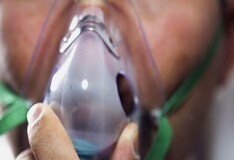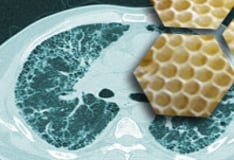September 22, 2009 (San Francisco, California) — Although data from 2 phase 3 trials show that ceftaroline (Forest Laboratories) is equivalent to ceftriaxone (Rocephin, Hoffman-La Roche) in achieving clinical cure rates for community-acquired pneumonia (CAP), the role for this new cephalosporin antibiotic might be limited, according to researchers here at the 49th Interscience Conference on Antimicrobial Agents and Chemotherapy.
Although ceftaroline is useful in CAP treatment, it is not as powerful as other novel cephalosporins against problematic Gram-negative organisms, according to researchers at the meeting. However, ceftaroline does show activity against common pathogens associated with CAP, including Streptococcus pneumoniae and Staphylococcus aureus. It also might be useful against pathogens that are causing increasing concern, such as methicillin-resistant S. aureus (MRSA) and multidrug-resistant S. pneumoniae.
"It's a next-generation cephalosporin that shows very potent in vitro activity against MRSA and drug-resistant bacteria," noted Paul Eckburg, MD, director of anti-infective development at Cerexa Inc (a subsidiary of Forest Laboratories), and lead researcher on the 2 phase 3 trials on ceftaroline, called FOCUS 1 and 2. "The significance of our studies is that they show we have a new antibiotic to treat CAP, especially that due to resistant organisms," he said.
In the 2 FOCUS trials, 1228 hospitalized adult patients with moderate to severe CAP requiring intravenous therapy were randomized to receive either IV ceftaroline 600 mg every 12 hours for 5 to 7 days, or once-daily IV ceftriaxone 1 g for 5 to 7 days. Baseline characteristics, including common comorbid conditions, structural lung disease, and previous pneumonia and asthma, were similar in the 2 groups.
The overall clinical cure rate in the ceftaroline group was 84.3% and in the ceftriaxone was 77.7%. Both drugs were well tolerated, but adverse events in the ceftaroline group were more frequent. The most common adverse events for ceftaroline and ceftriaxone were diarrhea (4.2% and 2.6%, respectively), headache (3.4% and 1.5%), and insomnia (3.1% and 2.3%).
Clinical cure rates were analyzed according to pathogen. The results showed that the cure rate for ceftaroline and ceftriaxone in patients with S. pneumoniae was 85.5% and 68.6%, respectively. Cure rates in those with multidrug-resistant S. pneumoniae were 100% and 22.2%, respectively, and cure rates in patients with S. aureus were 72% and 60%, respectively. According to the researchers, clinical cure rates were similar for the 2 drugs against typical Gram-negative respiratory pathogens such as Haemophilus influenzae, Haemophilus parainfluenzae, and Kiebsiella pneumnoniae.
Taken together, the results indicate that the phase 3 trials met their goal, which was to demonstrate the noninferiority of ceftaroline to ceftriaxone, Dr. Eckburg said.
In a press release, Forest Laboratories announced that they intend to submit a new drug application for ceftaroline to the US Food and Drug Administration at the end of this year for treating CAP and complicated skin and skin structure infections.
Despite the positive findings of these 2 trials, researchers at the meeting expressed doubts about the medication. Compared with other late-generation cephalosporins, ceftaroline lacks extended-spectrum activity against hardy Gram-negative organisms, such as Pseudomonas, and pathogens with AmpC- or extended-spectrum beta-lactamase resistance, said Luke Chen, MBBS, FRACP, assistant professor of medicine in the Division of Infectious Diseases at Duke University Medical Center in Durham, North Carolina.
"Ceftaroline has a high affinity for penicillin-binding protein 2a and has potent bactericidal activity against drug-resistant Gram-positive bacteria, including penicillin-resistant Streptococcus pneumonia and methicillin-resistant Staphylococcus aureus," he said.
The data from these 2 studies show ceftaroline as a promising new agent with potential use in CAP, according to Dr. Chen. But ceftaroline lacks extended activity against hardy Gram-negative pathogens, and this will likely limit its role in the treatment of hospital-acquired pneumonia, Dr. Chen said.
"Even if it is approved, the benefit it provides will be incremental," added Frank Lowy, MD, professor of medicine at Columbia University in New York CIty. "It may be a good new cephalosporin, but it won't change how we treat CAP," he said.
Dr. Eckburg is an employee of Cerexa Inc. Dr. Chen has disclosed no relevant financial relationships. Dr. Lowy receives research support from Pfizer and Cubist.
49th Interscience Conference on Antimicrobial Agents and Chemotherapy (ICAAC): Abstract L1-345a. Presented September 12, 2009.
Medscape Medical News В© 2009 Medscape, LLC
Send press releases and comments to news@medscape.net.
Cite this: Two Phase 3 Trials Show Benefits of Ceftaroline for Community-Acquired Pneumonia - Medscape - Sep 22, 2009.













Comments